
What Is Productivity?
Let’s define productivity first:
Productivity represents the efficiency of a person to perform a specific task.
We often think it is a state of constant efficiency that allows us to do everything faster and better, but this is wrong. Productivity is a measurement per individual task. With some assignments, you are very productive, while with others, your efficiency is terrible.
It’s because, for some tasks, you unconsciously are doing the right things, while for the others, you need to rethink your approach. And this also means that you can focus on those more important tasks and become more efficient at them.
At the end of this guide, you will have all the necessary knowledge to analyze your approach toward different assignments and make the corresponding adjustments to be more productive. It helped me land an offer at facebook and become a part of Toptal — one of the best freelance communities on the planet, and I hope that it will help you, too.
The Four Levels Of Mastery
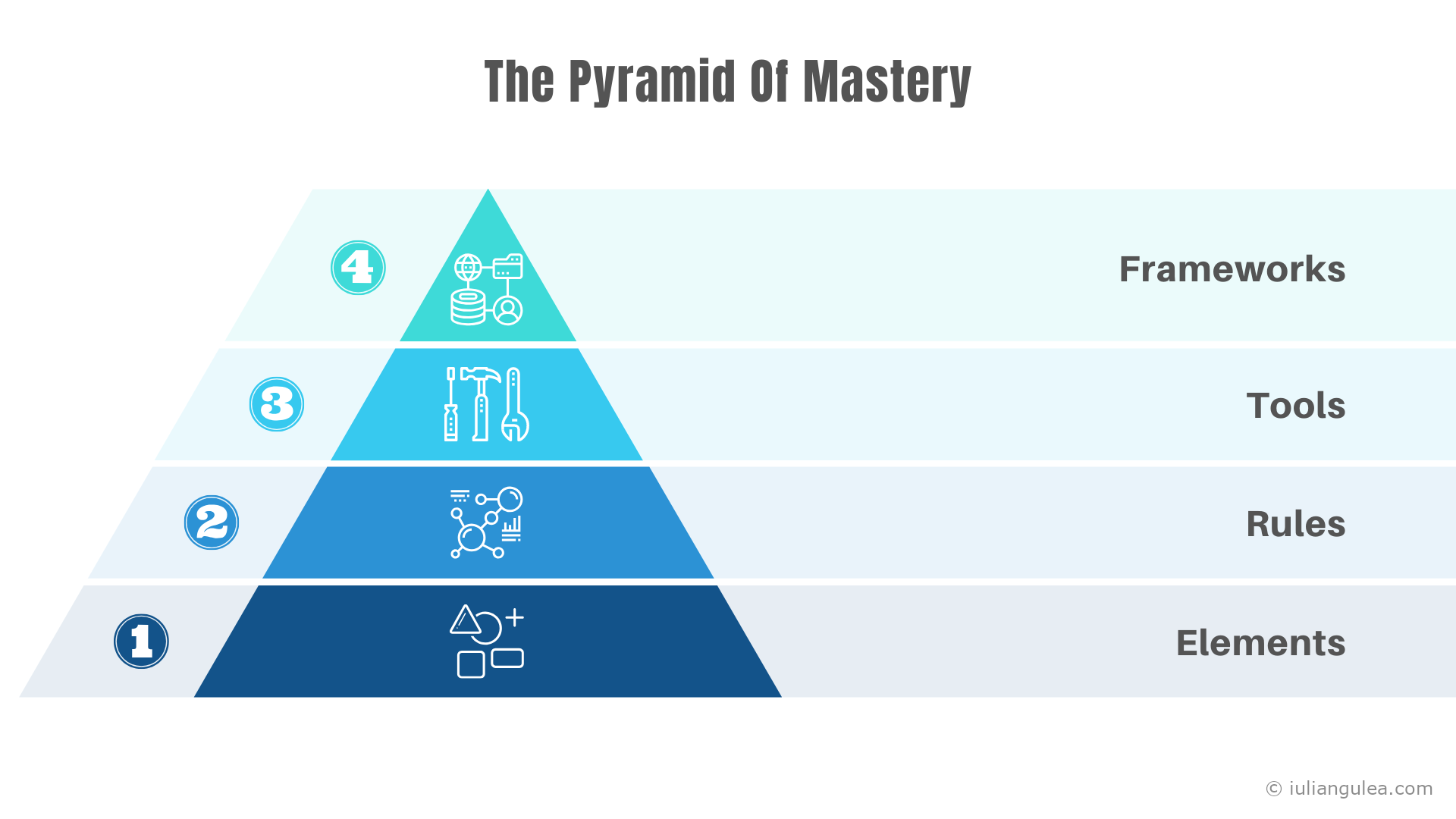
Before diving into different productivity techniques, let’s first dive into more details about the essence of productivity. And to do that, I will use the Pyramid of Mastery — a model that allows you to understand better a domain of interest, its constituent parts, and how to become an expert in it.
It does so by defining a domain through four types of entities:
- Elements. These are the building blocks of the field of interest, that include concepts, ideas, and entities;
- Rules. These are the laws that govern a domain. This layer comprises both rules that define the interaction between various Elements as well as organizational and governing rules at the domain level;
- Tools. These are the instruments you use to perform the activities within a field;
- Frameworks. These are combinations of the above levels that allow for faster achievement of preset goals for which the Framework was created;
For an in-depth explanation of the Pyramid of Mastery, you can read the original article on it.
Now, once you have an understanding of the model, let’s see how we can define productivity through the prism of it.
Productivity Elements
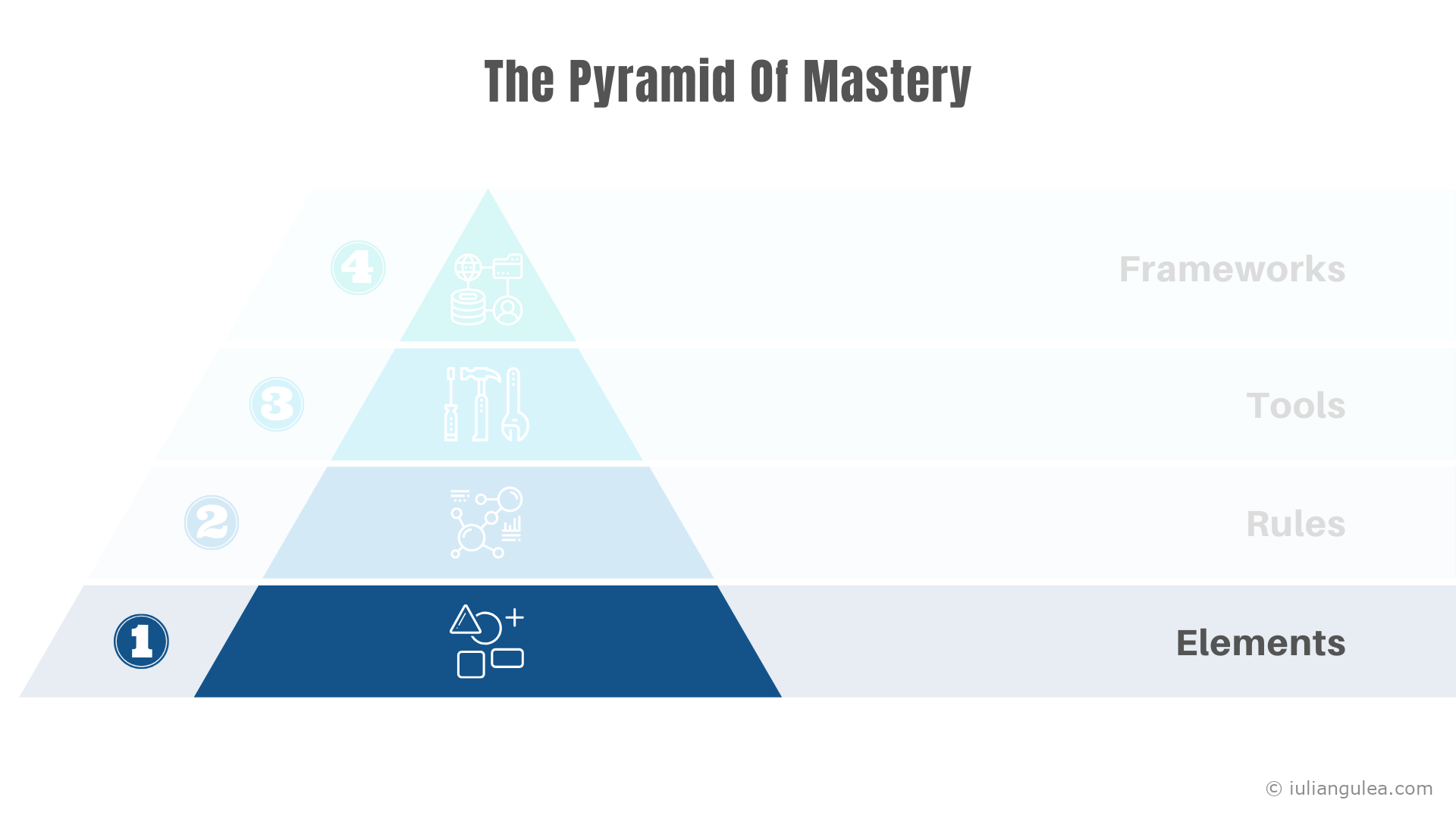
What are the Elements of productivity, the building blocks that you need to know about in order to excel at it?
I find this to be the most underestimated and overlooked layer. Very few people are thinking about what makes a productive person or about what productivity consists of. Instead, they try to squeeze in more time using tools, calendars, and other tools.
But knowing the fundamentals is vital if you want to become an expert in something. Therefore, here are some of the Elements that can help you be more productive if you understand them.
Human Senses
Our senses are the only mechanisms that allow us to get information about the world around us. Humans have five main senses through which they receive information:
- Vision
- Hearing
- Touch
- Smell
- Taste
Each sense has its own throughput:
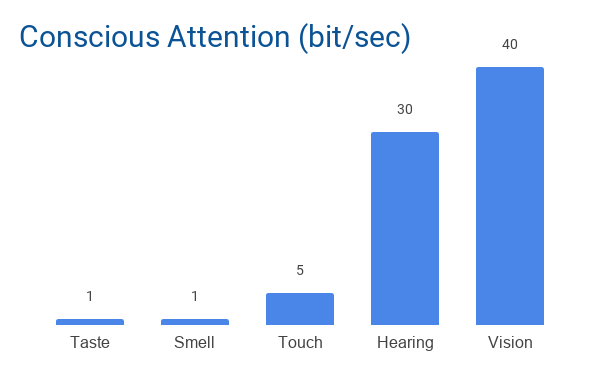
Therefore, we receive the most information visually, then through hearing, touch, smell, and taste.
If you are interested in the topic of human senses, I wrote a separate, in-depth article about it.
Attention
We receive a flood of information through our senses at every moment, but only a tiny bit of it reaches our awareness. This filter that orients our focus toward different stimuli is attention.
Attention is the process that selects which sensory information is preferentially processed and ultimately reaches our awareness.1
There are two types of attention: Goal-Directed attention (GDA) and Stimulus-Driven attention (SDA). The GDA is the voluntary effort to focus on something, be it reading this article, cutting vegetables, watching a movie, or writing code.
On the other hand, SDA is the involuntary reaction toward stimuli that are salient enough to grab our attention:
- contrasting things (stillness to movement, loud to soft, silence to sound, dark to bright, etc.);
- intensity stimulation (extreme sounds, sights, etc.);
- certain impulses we find vital or appealing (dangerous things, beautiful things, shiny things, etc.);
If you are interested in the topic of attention, I wrote a separate, in-depth article about it.
Working Memory
For tasks that require cognitive effort, once we focused our attention on a specific subset of stimuli we got from our senses, it is only here that we can finally perform some mental work.
Working Memory is the place in our memory where we can consciously process and manipulate data. It has a fundamental limitation, though: its processing capacity is limited to ~4 chunks of information.
A chunk is a relative unit of measurement that depends on different factors, such as:
- familiarity with the topic;
- complexity of the concept;
- one’s mental agility;
For instance, in the simple task of solving this simple math equation 21 * 2, you have to store number 21 as a chunk, store number 2 as another chunk, then, having these 2 in your working memory, do the multiplication, and store the result 42 as a third chunk.
However, in a debate on “homeschooling vs. formal education,” both concepts each represent a chunk. As it is a complex concept, you can then zoom in or out on either of those as information is stored in a complex network of associations in our brain.
If you would like to learn more about working memory, I wrote a separate, in-depth article about it.
Long-Term Memory
Our Long-Term Memory (LTM) holds all the information, knowledge, skills, plans, and memories. What you commit to the LTM can stay there for your whole life. Although there is a tendency to forget things, you can strengthen your memories using repetition.
Task Process
A task usually represents a specific result you want to achieve (e.g., write an article, build a website, create a marketing campaign, etc.). But behind any such assignment, there is a sequence of steps necessary to complete before you can say that you have done the task. It is called a process.
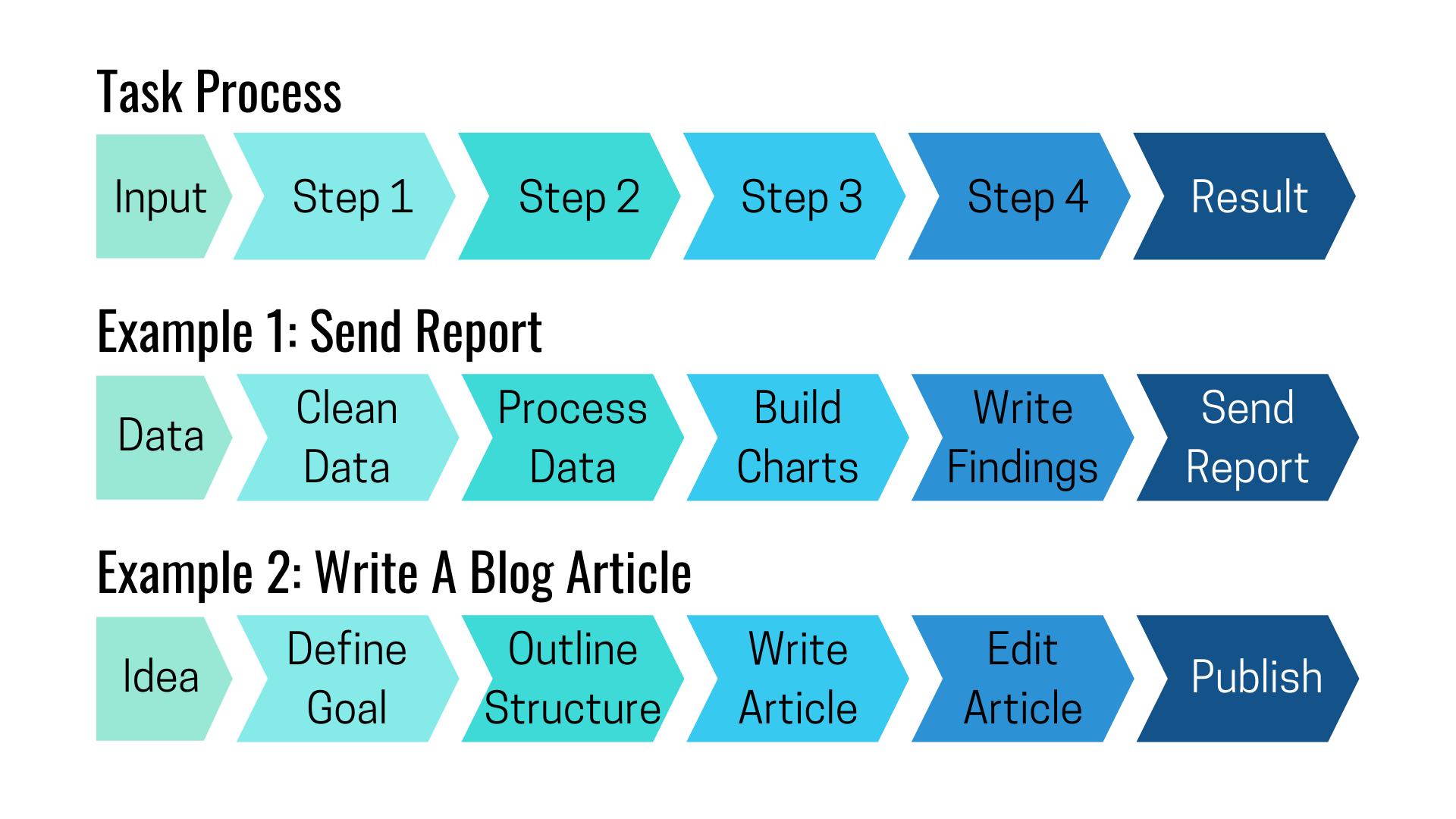
Each step in the process is a smaller task that will advance you closer to your desired result.
Learn and understand the necessary steps needed to achieve the end goal — it will show you what you are doing well and where you are wasting your time. Besides this, it is always easier to follow a list of specific action steps rather than figure out what to do on the fly.
Domain Specific Elements
Finally, since productivity is measured per task, it means that besides the Elements mentioned above, there are some domain-specific ones that you must also understand to be more effective.
And this is valid for all layers of the pyramid — you must know your domain of activity. Otherwise, you cannot be productive in it since you will have to learn a lot, and learning is a slow and effortful process in itself.
Now, once we have enumerated the primary elements, let’s discuss the Rules that govern the domain of productivity.
Productivity Rules
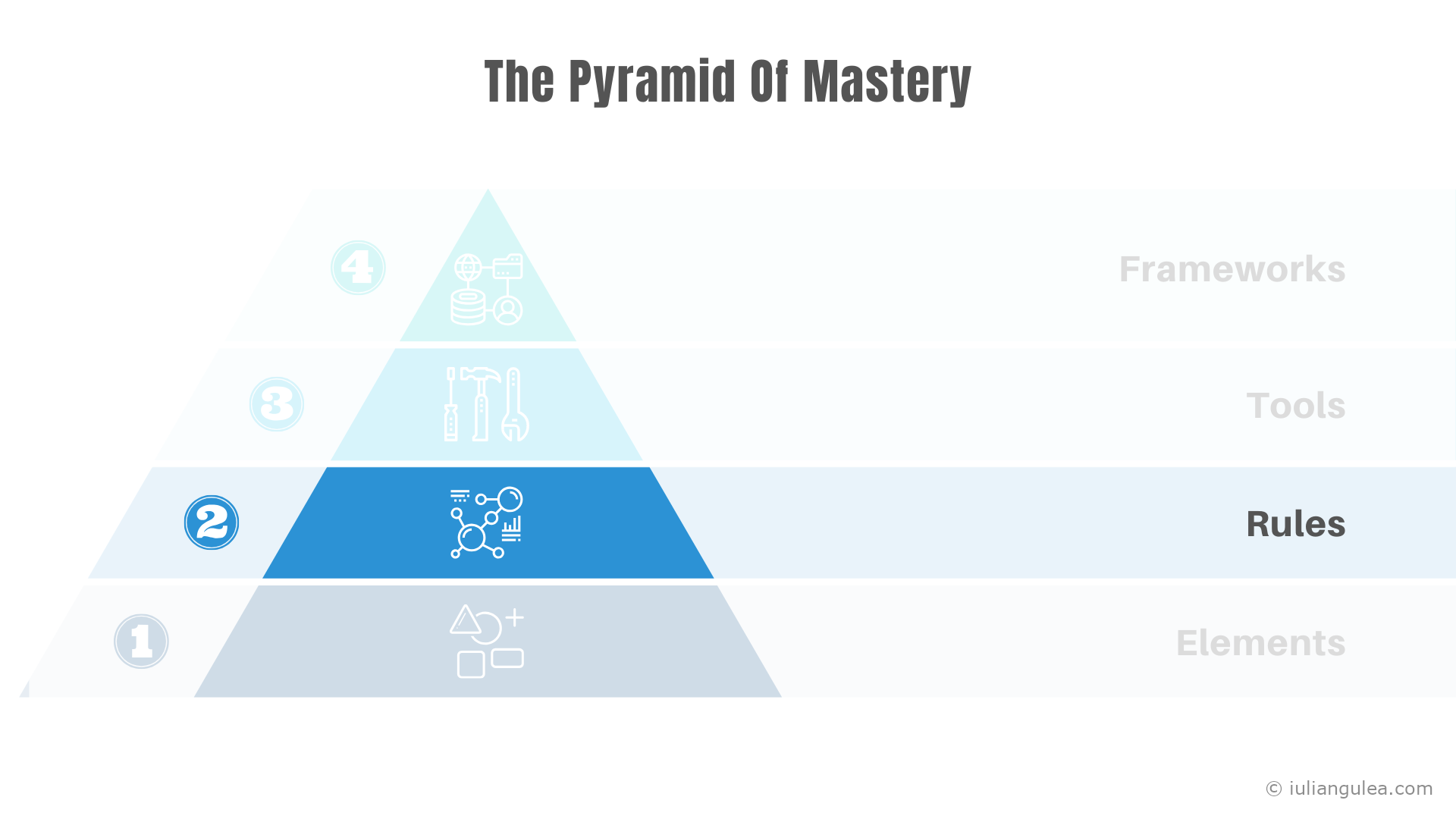
How the Elements we have enumerated interact? Here are some essential Rules that govern how we function and perform cognitive work.
Stimulus-Driven Attention Overrides Goal-Directed Attention
Imagine that while you are reading this article, you hear the sound of a breaking plate in the kitchen, which distracts you from reading. Or you are working on a report, and suddenly, the light starts to flash, thus distracting you from the job.
Stimulus-Driven attention can override your voluntary, Goal-Directed attention. This is bad news for productivity since, most of the time, working on a task means we have to engage this Goal-Directed attention to focus on some things consciously. And because those things might be boring, monotonous, or uninteresting, we can get distracted much easier by any unrelated stimulus.
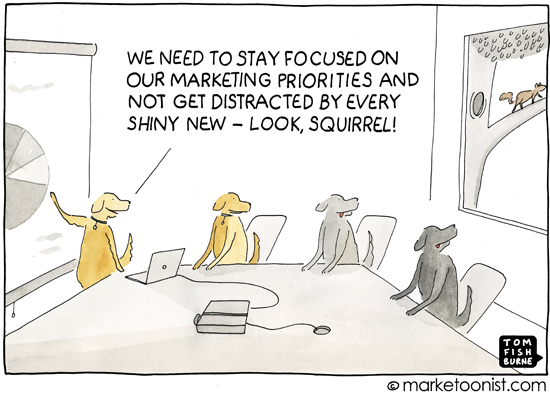
The following stimuli are all capable of distracting your Goal-Directed Attention:
- high-contrast changes in our environment (stillness to movement, loud to soft, silence to sound, dark to bright, etc.);
- intensity stimulation (extreme sounds, sights, etc.);
- some certain impulses we find vital or appealing (dangerous things, beautiful things, shiny things, etc.);
- “important” (e.g., one’s own name).
Working Memory Is Physiologically Incapable To Multitask
Imagine you are in a warehouse with an immense storage capacity (that’s your Long-Term Memory), a single small table with four zones where any kind of work can be performed (that’s your Working Memory), and a storekeeper who does all the work and knows where everything is stored. One constraint is that the storekeeper can work only at the table, so you must first put it there before doing anything.
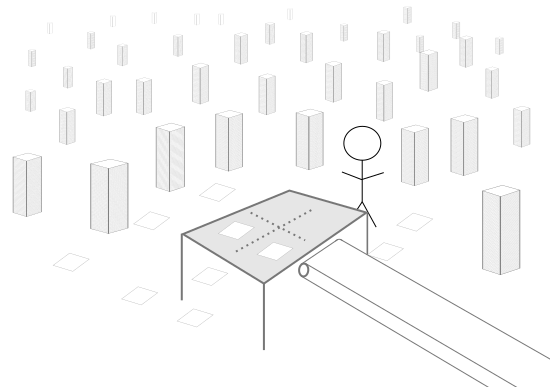
Each chunk takes one slot on the table. And you can get it either from your senses (imagine a conveyor system that brings things directly to your table) or search in the warehouse (which takes time).
Suppose you are working on a report. The storekeeper searches for relevant information in your Long-Term memory, puts it on the table, takes some from the conveyor, and puts it on the table as well, where they can manipulate, combine, dissect, and mix those concepts.
But suddenly, you are being called by your spouse regarding the plans for the weekend. Ideally, the storekeeper should take the time to carefully take the chunks off the table and put them in a dedicated place where they can find them later. In reality, however, the storekeeper sweeps off in a hurry everything from the table and rushes to put on it chunks related to plans for the weekend: movies, cuisine, activities, etc.
Then, when you are done talking with your spouse, you stare blankly at the computer screen, trying to recall what you were doing before the call. The storekeeper runs hysterically around the table in these moments, trying to find out something, but they don’t know what exactly to look for. Finally, you see the opened MS Excel window and remember you were working on the report.
But then another problem arises. You cannot recall the latest thoughts you had just before the call. The storekeeper cannot find the chunks they swept off the table. They looked everywhere, but the chunks just vanished. And so you need to start anew — loading information onto the table and manipulating it.
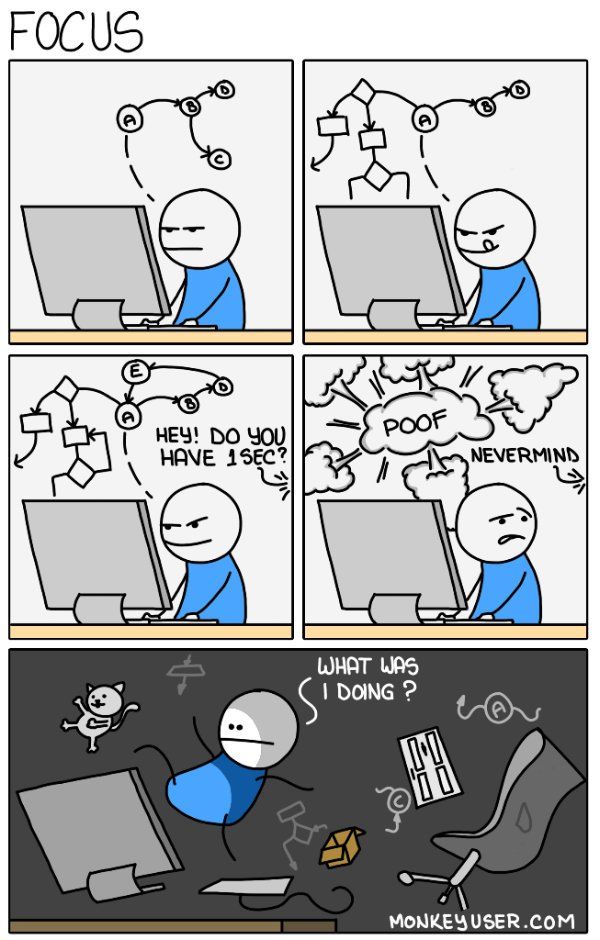
The above analogy is an oversimplification of the actual process, but it shows the approximate steps. Each time you have to switch tasks, there is an additional cost to change the context as well.
In addition to time costs, interruptions during multitasking increase the stress and frustration levels.2
Working Memory Needs Rest
Although this might not be a surprise at all, people still err at this time and again. Working Memory accuracy decreases significantly (in some cases by ~20%) when a person is sleep-deprived.3 Chronic sleep-deprivation might be even worse.
These are only some of the Rules that define productivity. Let’s move on to productivity Tools.
Productivity Tools
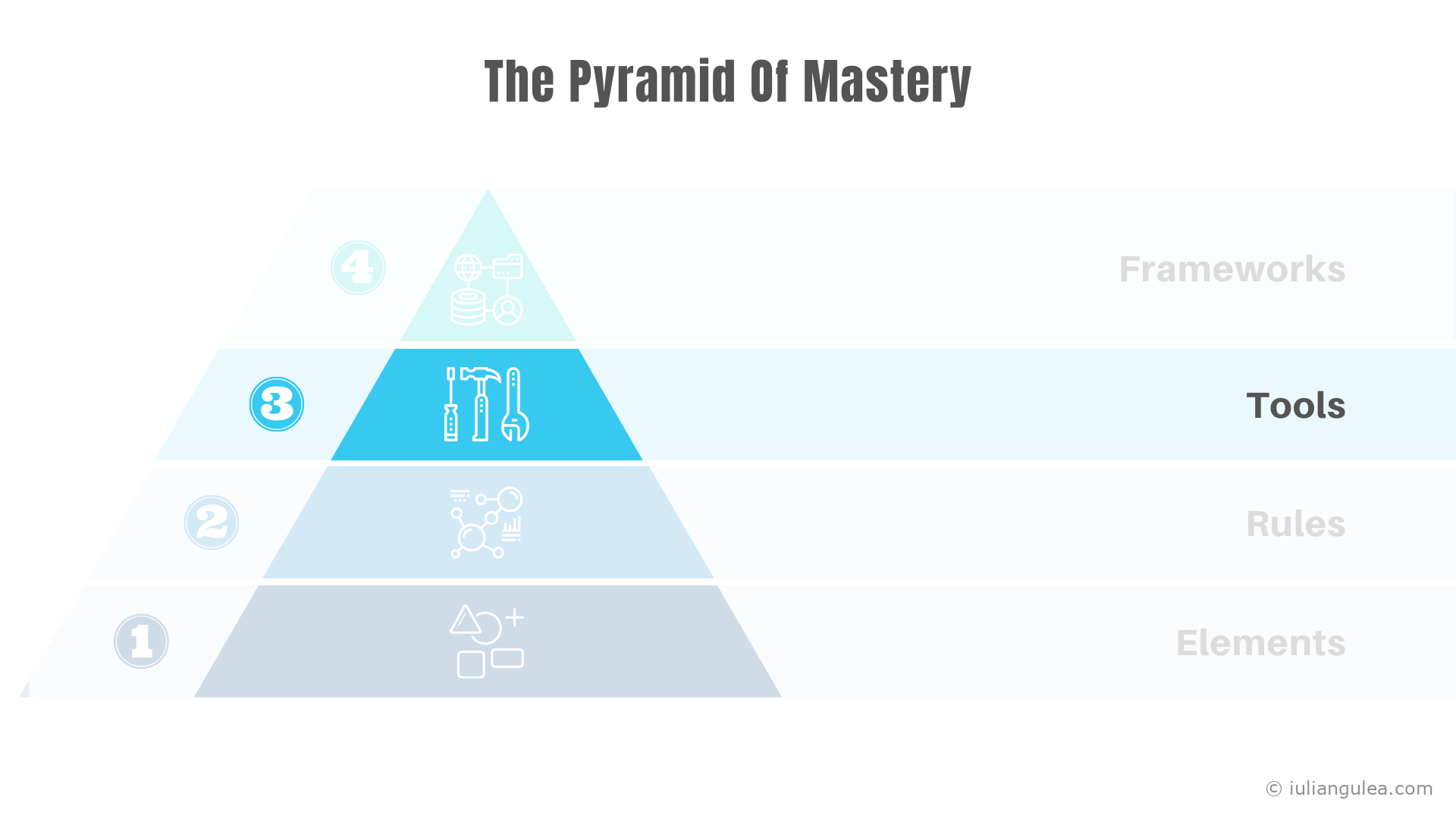
If the Elements layer is the most underestimated layer, productivity Tools are the most overvalued segment. Don’t get me wrong — tools are important. But a tool is just an instrument that allows you to better/faster/easier/more efficient/etc. interact with Elements according to the Rules.
There are a ton of tools for productivity in the form of apps:
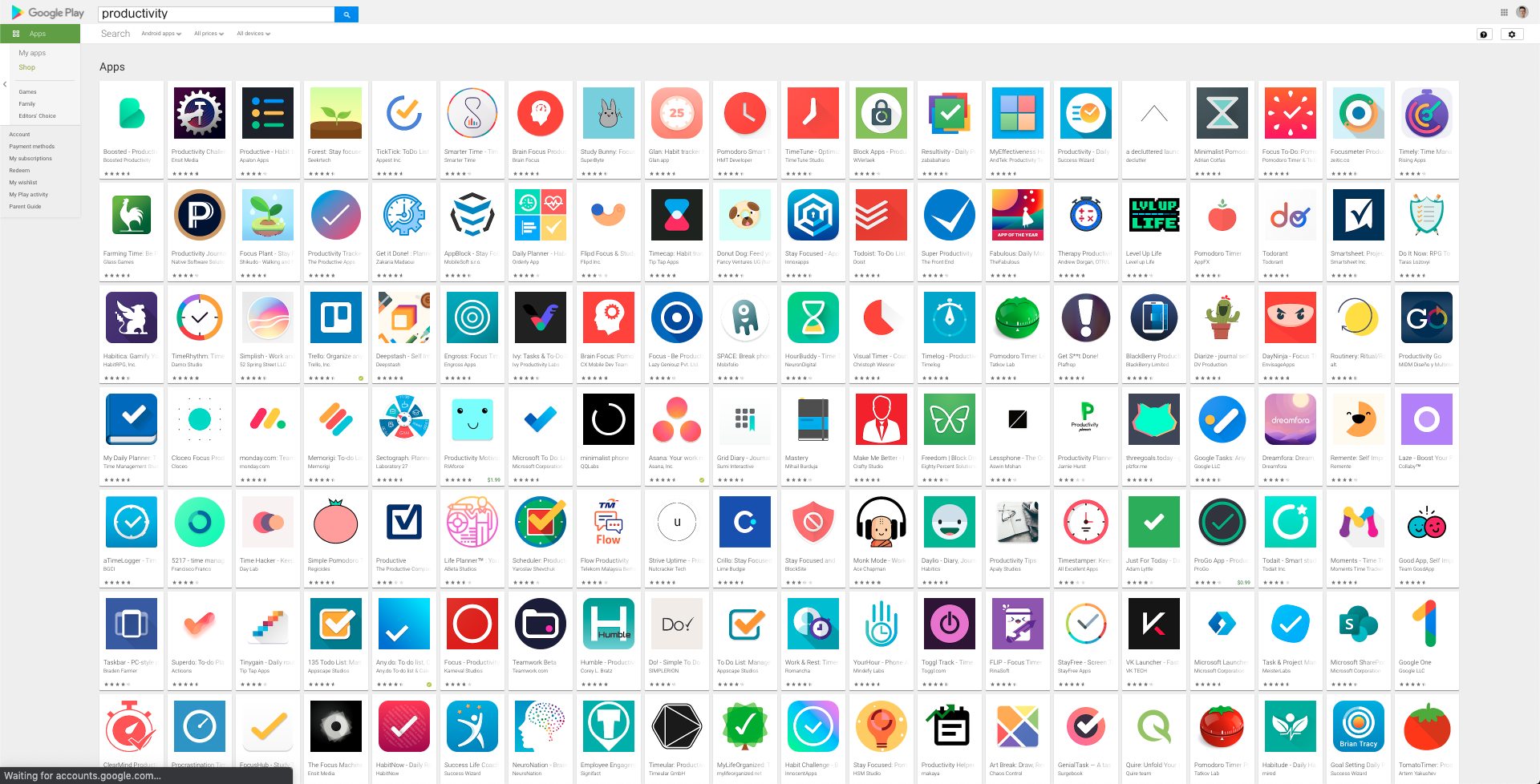
But generally speaking, productivity tools (not only apps) aim at one of several things:
- Aid your Working Memory. These tools either split big tasks into smaller and more manageable chunks (e.g., task organizers and TODO lists), free up WM resources (e.g., using calendars and setting reminders for some meetings, events), or enhance your processing WM capacity (e.g., by writing/drawing concepts on paper, you don’t need to store those concepts in memory and can focus on processing).
- Keep Stimulus-Driven Attention under control to let your Goal-Directed Attention focus on what’s important. These tools include apps that block access to other apps on your smartphone and computer, noise-canceling headphones to keep distracting sounds away, working space organizers to keep a clean desk.
- Speed up and simplify some actions. These tools include either programs that allow you to perform some tasks more efficiently (e.g., text expansion tools that can substitute short user-defined abbreviations with frequently used phrases) or physical devices that also make your life easier by performing some action better/faster/more qualitative.
Productivity Frameworks
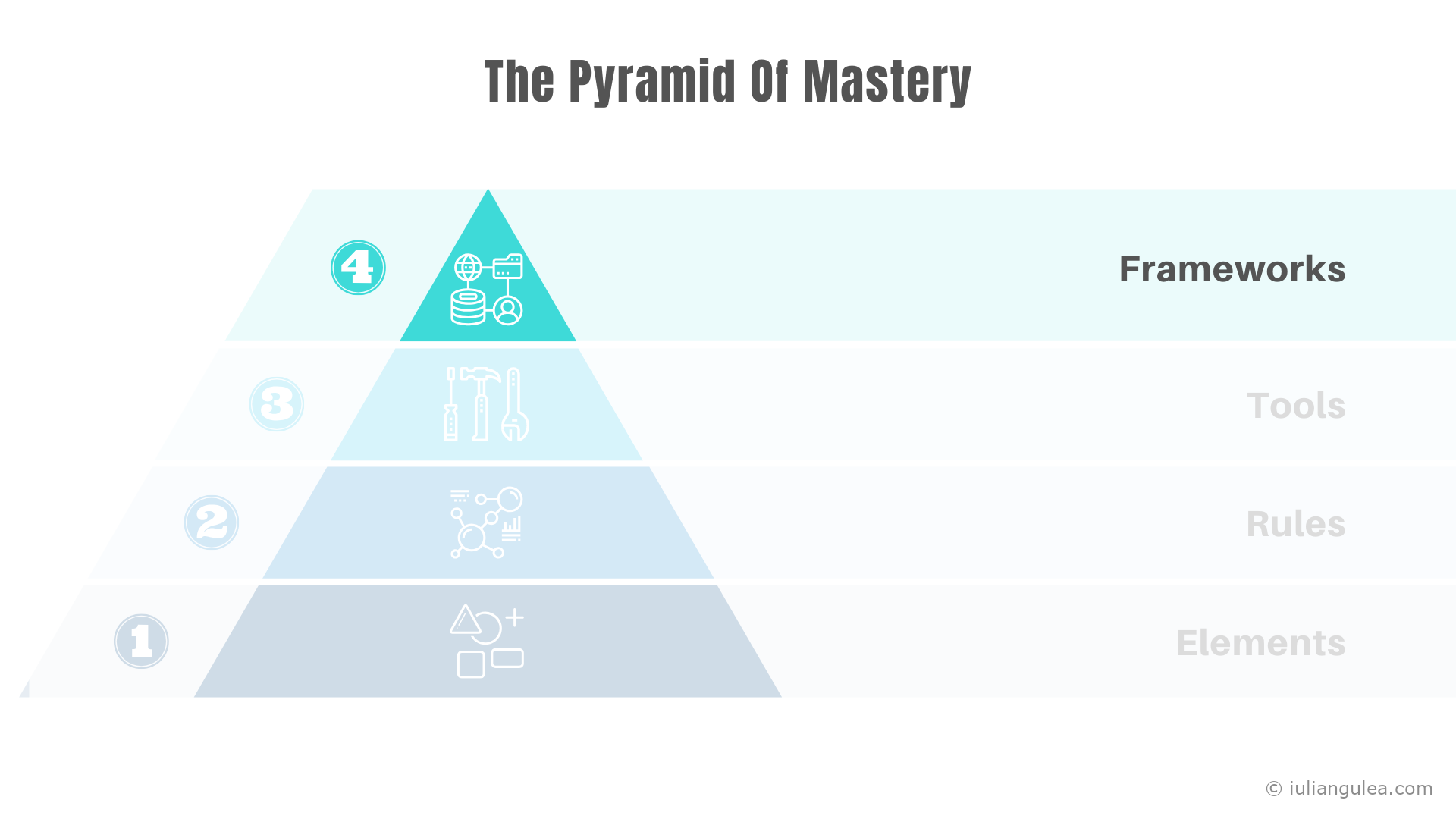
Frameworks are a collection of Elements, Rules, and Tools that combined allow for a more seamless achievement of a set of goals.
There are some efficient and inefficient productivity frameworks on the internet. I will review those in a separate article, but most of them address a specific part of the workflow between planning and getting the end result.
Still, to give you an example of what an efficient and inefficient framework looks like, here are two frameworks you might have heard of:
The Pomodoro Technique. It says to split your work into periods of 25 minutes (called pomodoros), followed by a 5-minute break. After four pomodoros, take a longer 15-30 minute break. While having breaks during the day is essential, the rigid timeframe this technique puts you into is counterproductive and wastes your time. There are two main reasons for this:
- if it took you less than the allocated 25 minutes to perform a task, you can either wait for the next pomodoro (and waste time) or start the next one (and risk pausing it as you won’t finish it);
- if you are in the middle of productive work and the 25 min period is over, it makes no sense to stop the work if you need an extra 5–7 minutes to finalize everything;
This technique fits better if you need to do some admin work that doesn’t require too much focus.
1-3-5 List. This one is more useful since it aims at splitting your workload into tasks of different sizes that you can perform under different energy levels during the day. It says that you allocate the daily work into three different buckets:
- 1 priority task
- 3 midlevel tasks
- 5 low hanging fruits
There are other, software frameworks, that can boost your productivity, like Google Suite or Office 365, that offer integrated solutions for your work (email + word + spreadsheets + presentations + other stuff).
These are the main components of the Pyramid of Mastery. The list is not exhaustive, but it covers all the essential parts. Now, with this newly acquired knowledge, let’s see how you can improve your productivity.
9 Productivity Tips To Be More Efficient
1. Use Visual Aids
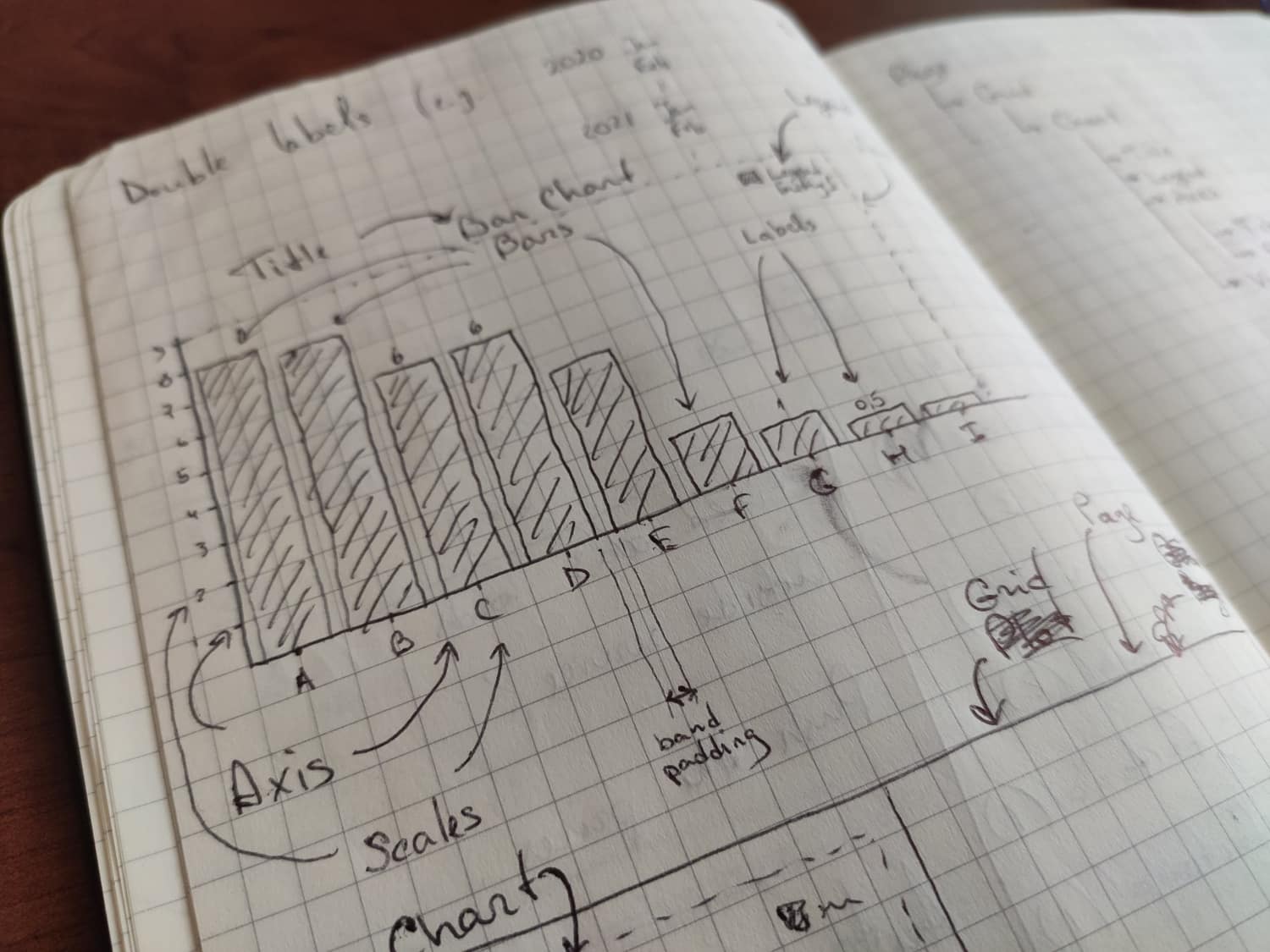
A pen and a piece of paper are sometimes the best, simple, and most efficient productivity tools you can use.
If the task you are working on relies on manipulating multiple pieces of information at a time, write them on paper or draw a diagram. That will free up resources necessary to store them in your working memory so that you can focus on processing and manipulating them instead.
This will also involve your visual sense, allowing you to make more potentially relevant connections between ideas.
2. Reduce Distractions As Much As Possible
There is a simple yet profound truth related to productivity:
If there is something that can distract you, sooner or later it will distract you.
Therefore, if you want to keep focused for a longer time:
- take care of visual distractions: clean your working zone so that you do not inadvertently trigger any visual associations with objects that are on your desk;
- take care of auditory stimuli: use a pair of headphones to save you the trouble of constant distraction by your noisy teammate, neighbor, kids, that weird and loud laugh of your coworker, or any other disturbing sound;
- take care of kinesthetic stimuli: use comfortable clothes and set the right temperature in the place you are working in to feel not too hot or cold;
- take care of smell distractions: any smells will distract you, so make sure you ventilate the place regularly;
3. Put Your Phone Away
This tip deserves a separate point on its own. Put your phone on silent mode and away from your sight (not in your pocket).
I bet you can reproduce the sound from your messenger notification in your mind right now. All those sounds (including other notifications, calls, etc.) are nothing else than stimuli that have their primary goal to engage our Stimulus-Driven attention and distract you from the thing you are focused on. It is also essential to put the phone away, as having it in your area of sight will also grab your attention either when the screen turns on upon receiving a notification or simply when you see it on the table.
4. Your Energy Is More Important Than The Allocated Time
I find Time Management overrated. It’s not that timing your tasks is not important, but time is an absolute measure independent of anything. The fact that you dedicated 30 minutes to do an assignment means that you will focus on it for that period no matter what and then have to switch to something else for another 30 minutes or one hour.
Consider your energy levels when planning your tasks. Your energy is what really matters when working on a task. You can spend 2 hours banging your head against an idea in the evening when you are tired and then complete that task in 30 minutes the next morning. Know when you are more productive and work on the most important tasks then.
Also, be flexible. Sometimes you might be in the middle of some very intensive and productive work, but your schedule says that time’s up. Unless your next task is a meeting, consider continuing to work on the job, as your momentum will help you achieve more.
5. Ask For Productivity Time
Sometimes you are in the flow, working in silence, with your headphones on, all the social network tabs closed and phone away, and then, especially in the pre-COVID-19 times, someone pats you on the shoulder and asks whether you want to grab a cup of coffee.
Even with the #WorkFromHome situation, kindly ask your coworkers and family not to disturb you for the next X hours.
6. Split Your Tasks Into Manageable Chunks
If an assignment is too big for you to comprehend, consider splitting it into several smaller tasks until you get them of a size that you can easily accomplish. Huge tasks have too many details, and our Working Memory, with its limited capacity, does a poor job when trying to process it all at once.
Instead, divide the assignment into smaller, bite-sized subtasks so that you can focus and do them faster and more efficiently.
A positive side-effect of this is that smaller tasks provide a sense of progress, positively affecting your overall state and mood.
7. Prioritize Your Tasks And Define Task Steps
Prioritization is one of the hardest things to do since it implies comparing abstract concepts of a different nature. Besides, it is always easier to follow a list of steps rather than having only the destination in mind.
Plan your tasks the night before. Write down the essential assignments you would like to work on the next day.
And if you take 15 minutes to write down all the necessary subtasks of a task, you will save several hours down the road and spend less energy on the actual work. When you have an exact, step-by-step list, you free yourself from deciding on the next step after each prior assignment.
8. Use Good Tools And Learn Them Well
This one is related more to the tools you use to perform the actual work.
If you use software tools, learn the shortcuts of the programs you work in as it will save you tens of hours within a year.
If you use physical tools, buy high-quality tools, as they will pay off multiple times.
9. Your Expertise Is Directly Proportional With Your Productivity
I have mentioned earlier that you need to know the domain you are working in. That statement does not reflect the full picture:
Your productivity is directly proportional to your level of expertise in a field: the better you are at your job, the more productive you will be.
Becoming Experienced At Being Productive
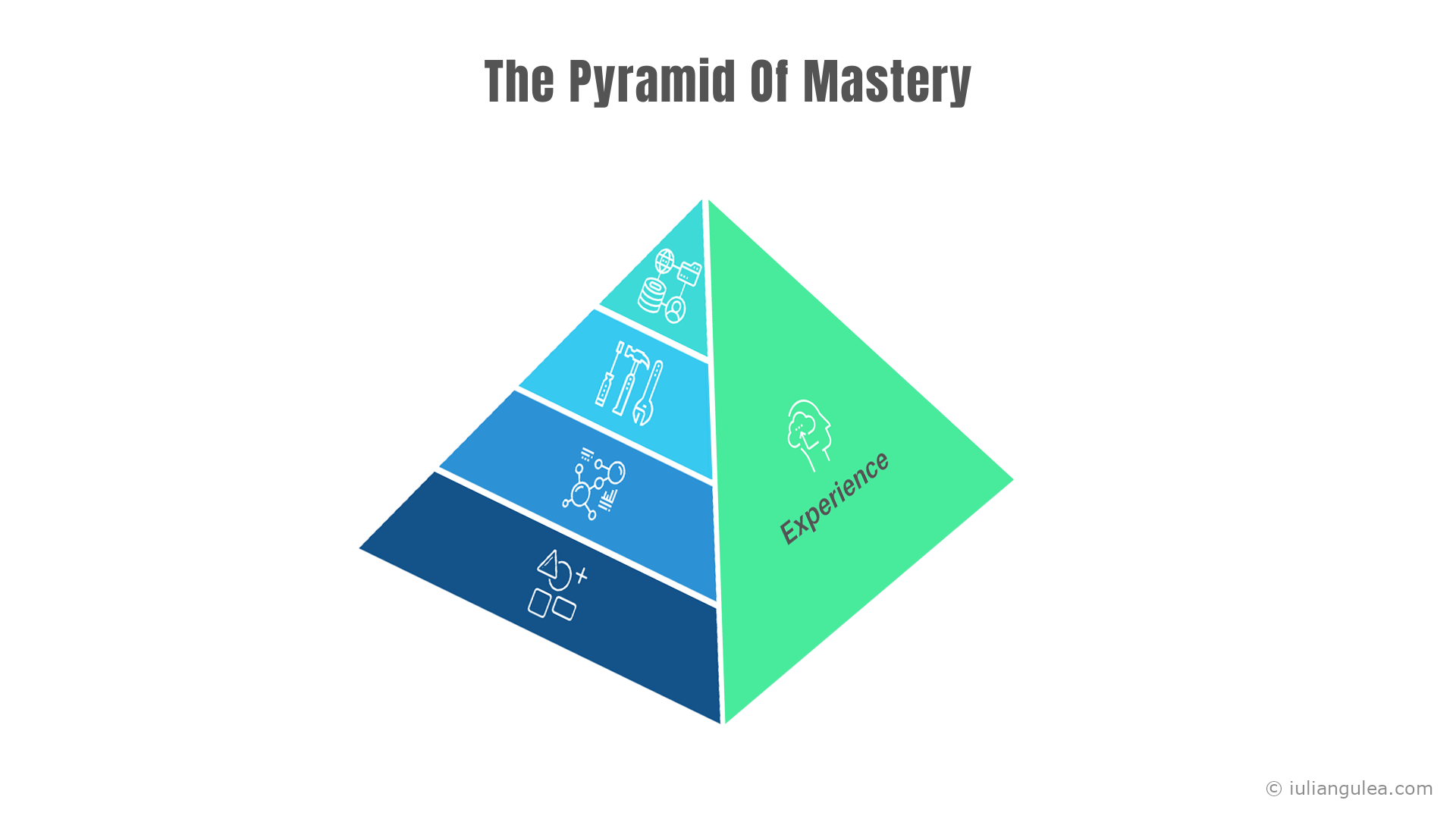
The Pyramid of Mastery has an orthogonal side — the plane of Experience. You can know the theory at perfection, but you won’t get any results unless you are going to put it into practice.
In the context of productivity, this means observing and getting to know what works and what doesn’t work specifically for you.
Human nature is only a partially solved puzzle, and there are many more unknowns than knowns. However, the things I have described in this guide are known universal physiological aspects of how humans function. Take them and put them to good use.
If you liked this article, consider subscribing below and following me on twitter (@iuliangulea).Asplund, C. L., Todd, J. J., Snyder, A. P., & Marois, R. (2010). A central role for the lateral prefrontal cortex in goal-directed and stimulus-driven attention. Nature Neuroscience, 13(4), 507–512. doi:10.1038/nn.2509 ↩︎
Mark, G., Gudith, D., & Klocke, U. (2008). The cost of interrupted work. Proceeding of the Twenty-Sixth Annual CHI Conference on Human Factors in Computing Systems - CHI ‘08. doi:10.1145/1357054.1357072 ↩︎
Chee, M. W. L., Chuah, L. Y. M., Venkatraman, V., Chan, W. Y., Philip, P., & Dinges, D. F. (2006). Functional imaging of working memory following normal sleep and after 24 and 35 h of sleep deprivation: Correlations of fronto-parietal activation with performance. NeuroImage, 31(1), 419–428. doi:10.1016/j.neuroimage.2005.12.001 ↩︎